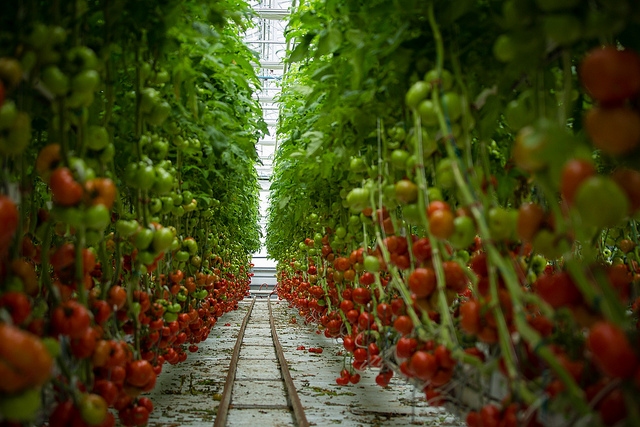Overview
The Need - the world’s urban population is growing, rural land is becoming more degraded and constantly pushed back as cities expand. The economic and environmental costs of our current, linear food system are rising and things are set to get worse.
The Solution - cities have acres of unused roof space which can be used to grow crops. Rooftop farms are perfect for rainwater irrigation as well as benefiting from free energy from the sun and residual heat rising from the buildings below. Distribution costs are greatly reduced, taste and freshness increase due to the proximity of customers.
What makes it particularly smart - Lufa Farms uses a hydroponic system rather than soil farming, allowing 100% recirculation of nutrient-rich irrigation water. Building and city infrastructure can also benefit as rooftop farms provide cooling/insulation as well as attenuate run-off.
The result - less than one acre of roof produces enough fresh produce each year to feed 2000 people, using 50% less heating energy, 50 - 90% less water and nutrients and reduce energy demands on the building underneath.
More choice but lower quality
Cities are vast consumers of food. London alone requires an estimated 30 million meals each day. The modern global food system, through greater industrialisation and globalisation, has evolved to supply these meals in the most efficient way possible, often compromising on quality and creating unaccounted environmental and social impacts.
Citizens in developed economies are fed via a large and complex supply chain, that starts with faraway producers and farmers using intensive, chemically-reliant methods. Harvested food is then passed through numerous stages of packing, re-packing, loading, unloading, freezing, refrigeration, sales and re-sales, until finally it reaches citizen’s plates. To endure this long ride, food products are selected based on logistical rather than quality criteria, so that durability, uniformity of shape and transportability are most important; whereas nutrients, taste, texture and smell are secondary.
The modern food supply chain has meant that eating strawberries in winter is no longer the privilege of kings. Furthermore, because of lower production costs in exporting countries such as South Africa and Costa Rica, prices remain fairly constant throughout the year. The normalisation of abundant choice means that the distance fresh food travels has increased massively. Fruit and vegetables from Spain, UK’s largest exporter of vegetables, travel more than 2000 miles from farm to fork. In the US, the average journey a meal makes is estimated at 1500 miles. Moving food such large distances requires energy for transport and refrigeration, generates carbon emissions and relies on vast amounts of packaging materials.
In countries such as Kenya and South Africa, where much of Europe’s fresh produce is grown, a less stringent and well-enforced regulatory context, can lead to environmental and labour standards well below the country where the produce is consumed.
In short: the true cost of all year round abundance and variety in our supermarket aisles is often not reflected in the prices that we pay.
Rooftop farms
It’s projected that by 2050 there will be 2.5 billion new city dwellers around the world. With an increasing density of mouths to feed, growing food where it will ultimately be consumed could offer significant benefits.
In Montreal, a company called Lufa Farms has started enacting the vision where food production is integrated into the urban fabric. Lufa Farms’ approach makes use of unused spaces, minimises resource use, producing fresh healthy food all year—even in the dead of winter.
Lufa Farms has achieved this by constructing three rooftop greenhouses (for a total of 12,821 square meters—or 3.7 acre—of growing space), on top of commercial buildings in the city. Inside lightweight aluminium and steel structures, herbs, greens, tomatoes, peppers and other vegetables are cultivated using harvested rainwater (and meltwater) and only biocontrols (no synthetic pesticides, herbicides or fungicides) to deliver fresh produce to local customers on the same day that the crops are harvested.
Within the greenhouses, Lufa Farms uses hydroponic farming techniques, which reduces the load on the roof structure compared to conventional soil. Hydroponics means that 50-90% less water is required, and the water that is used flows in a closed loop water system, which re-circulates irrigation water and nutrients.
Within one year of planting the first seeds in Lufa Farms’ Ahuntsic location—the world’s first commercial rooftop greenhouse—there was enough vegetables to supply 2000 people, using 50% of the heating energy an equivalent ground-level greenhouse would use, and much less water and nutrients than is normally needed.
Lufa operates slightly differently to other urban farms, it has a direct-to-consumer business model. On the website shoppers customise their food basket, which are delivered to one of 300 pick up points around the city. Lufa also partners with conventional farmers to maintain variety, thus preventing 'seasonal defection', the dispiriting period of winter characterised by an abundance of swedes and turnips.
Lower building and infrastructure costs
To be resilient and function effectively, a farm should be designed and managed, as one component of a larger system - the surrounding natural ecosystem. This way synergistic relationships can form, in which the farm and the environment can mutually benefit. In the context of regenerative agriculture in a rural context, such as Native Sugar, these benefits are evident in valuable ‘ecosystem services’ flowing to the farm - fertiliser nutrients, soil strengthening, water storage, pest control; in exchange benefits flow from the farm in the form of regenerated natural capital, increased biodiversity, enhanced water quality and avoidance of erosion.
A parallel could be applied to urban farms, where the design of farms are well-integrated with the urban ecosystem - the built environment. The difference is that instead of forests there are buildings; instead of streams, there are roads and sewers; and rich bio-diversity could be an analogue for a high quality of life for human and other city residents.
Lufa Farms’ rooftop farms appear to have achieved this synergy. Locating its farms on top of buildings provides a protective and insulating layer, which leads to lower energy demand for both the building and the farm, and a reduction in pressure on urban infrastructure.
The energy balance is just one of the many mutual benefits that arise:
Benefits to farm | Benefits to city ‘ecosystem’ |
Harvested rainwater (and meltwater) Heat from building below Reduced post harvest losses Reduced transport and packaging costs Fresh produce picked and delivered daily translates to reduced refrigeration costs | Reduced winter heating cost Reduced need for aircon in summer Reduces environmental cost of delivery Provides protective layer allowing it to last longer than conventional roof Reduce ‘heat island effect’ for city Sequester carbon dioxide and nitrogen Intercept and use rain and meltwater water instead of directing it and wasting to the sewers (reduces stress on the city’s infrastructure) Composting of green waste reduces stress on the city’s waste collection process Connects citizens with food |
The potential for more ‘greening’ of city roofs was quantified in 1999 in a study undertaken by the City of Chicago which estimated that $100 million of energy could be saved each year by following such an approach. Similarly, work has just started in the city of London to build a new $4.2 billion 15-mile super-sewer to stem the flow of 39m tonnes of raw sewage that regularly overflows into the Thames. This problem arises not because of sewage, but because of stormwater, which if intercepted and used for urban farming, could eliminate a significant chunk of infrastructure spending.
Win-win
As our urban population grows and the shortcomings of our industrialised food production system become more and more evident, we urgently need to change the way we feed our citizens.
Rooftop hydroponic greenhouses such as Lufa Farms represent a way of producing healthy fresh food, that makes effective use of underutilised urban space without significantly increasing demands on precious resources like water and energy. Furthermore, this type of approach gives something back to the city, in terms of lower energy usage, cleaner air, reduced stormwater and an important reconnection with food both through education as well as job creation.
Rooftop farming may not be able to provide all of our future needs, but could make a significant contribution. A study by the city of London estimates that buildings cover 24,000 ha of Greater London and that 3.2M sq m. could be ‘greened’. Applying the same productivity as Lufa Farms’ Ahuntsic rooftop farm, this area could provide enough vegetables for 2 million citizens, or approximately 20% of the urban population.
In a circular economy, economic activity builds and rebuilds overall system health. It also recognises the importance of diversity - large and small, global and local. Urban food production methods such as Lufa Farms represent the kind of distributed and integrated approaches we need to effectively feed our cities in the future.
Company info
- Founded in 2009
- 140+ full time staff
- HQ Montreal, Canada
- First commercial farm in 2011
- 3 rooftop farms - Ahuntsic (0.75 acre), Laval (1 acre), and Anjou (1.45 acre)
Further material: Video, images, Urban Ecology case study, CityLab








